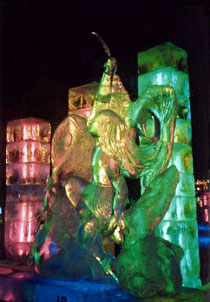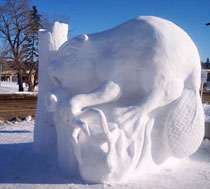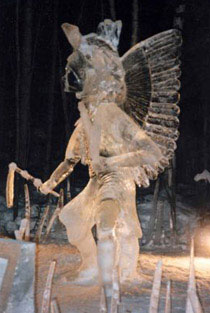

“Eagle Spirit,” 13th International Ice Carving Competition, Harbin, China, January 2002. This sculpture shows a Cree Indian reaching for an eagle feather at the top of a mountain which is shaped like an eagle. It won a Silver Medal and was carved in three days from a block of natural ice from the Songhua River, measuring 9' x 9' x 20".
Photo credit: Patricia Leguen

“Snow Beaver” a recent sculpture done in Saskatoon, 2007.
Photo credit: Patricia Leguen

“Pwatsimowin,” the Grass Dance, World Ice Art Championships, Fairbanks, Alaska, March 1997. This sculpture represents a traditional Cree Dance. It placed 7th in the single-block/realistic category.
Photo credit: Patricia Leguen
Patricia Leguen
About Ephemeral Sculptures
Snow, ice, sand, and fire are beautiful materials that nature gives us and takes back once the sculptures are finished. Snow is immaculate and looks like marble when it is polished. At international competitions each team is given a ten-foot cube of snow that has been compacted in plywood forms. Only hand tools are allowed. Most sculptors make their own tools or adapt existing ones: different types of shovels, metal rasps, and even heavy-duty sandpaper. It is very physical as you have to shovel several tons of snow before you can see the sculpture take shape.
Ice is like an uncut diamond waiting to be shaped. At international ice sculpture competitions, power tools are the norm: chainsaws, die grinders, disc grinders, but also ice chisels. At the World Championships held every March in Fairbanks, Alaska, teams have 20 tons of turquoise blue ice to carve in six days! Ice carvers work 9 to 15 hours a day in -10 to -35 degrees Celsius temperatures (-13 to -32º F). The tallest sculpture to date was 35 feet tall! Carvers are perched on scaffolds, and large pieces of ice have to be strapped and lifted with a forklift. Sculptors have to combine engineering skills with artistic skills to create these monuments out of ice.
Sand is fragile and unstable but so tactile. First, you have to nail together two-foot high wooden forms of different sizes or use plastic forms. You shovel sand in the base form, add buckets of water and use a tamper to pack the sand gradually until the form is filled up. You put the next form on top, which is smaller than the base form so you can use it to stand on. You repeat the process until your pyramid of forms is finished. Then you take the top form off and start carving, using the next form to stand on, and then you take the next one off and so on. You can also hand pack the sand without using any forms, but you can only go up to eight feet or so.
Each grain of sand is attached to other little grains of sand by the surface tension of tiny droplets of water. Sand sculptors use only hand tools: shovels, trowels and palette knives of different sizes and shapes, straws, brushes, etc. As you finish parts of the sculpture, you spray them with a mix of one third white glue and two thirds water to coat the surface and prevent damage from rain or wind. Sand has its limitations as every part of your sculpture has to been supported by another. If something collapses, you have to start over again. Your sand sculpture is judged not only by artistic criteria, but also in terms of narrowness, verticality, cut-throughs, and overhangs.
Fire is a fascinating medium and the most ephemeral of all. Sculptors have one day minimum to build a wooden frame with 2 x 1s and 2 x 4s on the ground. The frame is then covered with straw using twine and wire. The whole structure is sprayed with kerosene and then raised and secured to the ground with guy wires. When night falls the sculpture is set on fire and comes to life as it disappears.
Every ephemeral sculpture is a challenge. You have to create a piece outdoors in a set amount time in all kinds of weather. You have to learn how far you can go with the material before it falls down or collapses. But it is as if time stands still, you are in a different state of mind, a state of elation where you do not feel the pains and aches, where you forget about the intense cold or heat. You immerse yourself in your work, you are always testing yourself.
Monumentality is tempting and takes the artist even further than he or she thinks. Dimensions are not only felt intellectually but physically: you become part of your sculpture. And as soon as you finish it, you distance yourself from it and you do not even think about what will happen to it. You are already thinking about the next one…All that you are left with afterwards are photos and videos of your work, and also vivid memories in your mind.
—Patricia Leguen Sculptor, Saskatoon, Saskatchewan, Canada